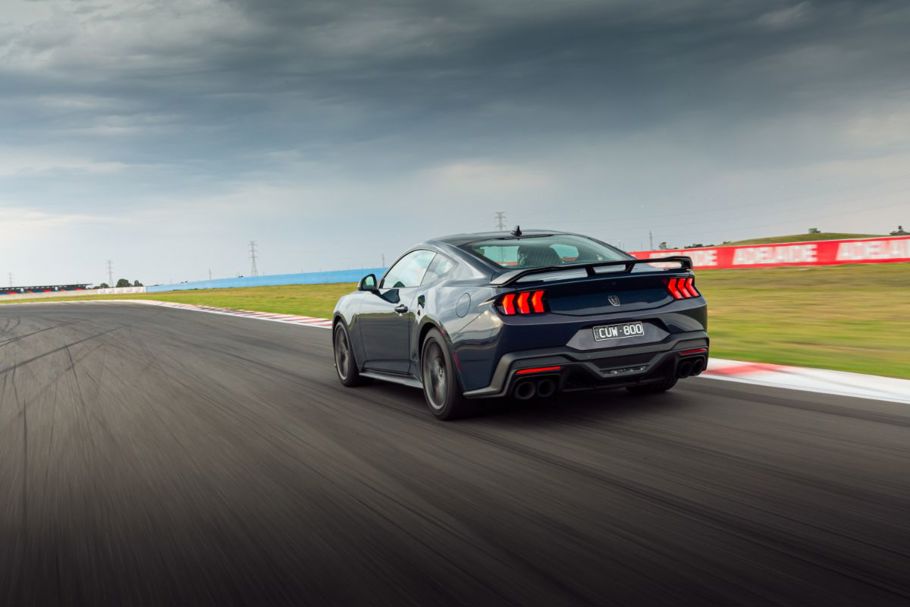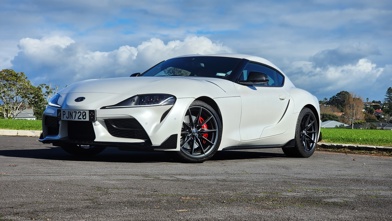Never before has a horse turning its head generated so much excitement. When Ford unveiled the seventh-generation Mustang in Detroit this time back in 2022 (yes, we were there), it pulled out a real surprise with the Dark Horse.

Special editions are nothing new for Mustang, but Dark Horse is a full factory development and therefore technically the first brand-new model name for Mustang since the Bullitt back in 2001.
It’s also now-rather-famously the first Mustang to wear a completely different horsey badge. The traditional galloping Mustang remains on the blacked-out grille, but on the guards and tailgate there’s a new badge with the horse’s head facing front, with geometric shading to suggest light and a mane.
The seventh-generation Mustang, just launched in New Zealand, is first-and-foremost an assurance from Ford that its classic internal combustion engine (ICE) sports car is alive and well and will continue for the foreseeable future.

The Dark Horse is the star car of the new ICE range, but Mustang also still comes in trad V8 GT fastback and convertible. We’ve just driven all three in Australia, some on-road and all around The Bend - an excellent racetrack at Tailem Bend, about 100km south-east of Adelaide.
Dark Horse is a full factory development and therefore technically the first brand-new model name for Mustang since the Bullitt back in 2001.
Mustang 7 is new, but not new-new, if you know what we mean. The 1960s-inspired styling is fresh apart from the doors, which are carried over. Same basic platform underneath, but the 5.0-litre Coyote V8 has been tweaked with a dual-intake and dual throttle body induction system and active-valve exhaust, with power increased to 363kW/567Nm (from 339kW/556Nm).

The steering and suspension have been sharpened, but this is also a much more refined and sophisticated car than before. And the interior… well, more about that in a minute.
That’s the GT. The Dark Horse is a more track-ready machine. Its V8 has been strengthened with piston connecting rods from the Shelby GT500 and has been bulked up to 373kW/567Nm. Not a massive increase, but enough to make it the most powerful production Mustang 5.0 yet.

It’s more about the chassis, of course. Dark Horse has unique suspension tuning, larger rear sway bars, heavy duty front shock absorbers and uprated Brembo brakes (although Brembos are also still standard on the GT).
Dark Horse is also the only way Kiwi buyers can get a Mustang with a manual transmission: it can be ordered with a Tremec 6-speed shifter.
There’s improved oil cooling, MagneRide suspension, a Torsen rear differential and staggered wheel sizes that are slightly wider than the standard car: 19-inch alloys that are 9.5in wide at the front and 10in at the rear.

Dark Horse is also the only way Kiwi buyers can get a Mustang with a manual transmission: it can be ordered with a Tremec 6-speed shifter, although the 10-speed automatic is also available.
Yes, it still rumbles. The active-valve exhaust has four settings, ranging from what Ford calls 'good neighbour mode' to various states of V8 riot.
Dark Horse has a different look, with shadow-finish surrounds (you know, to make things… darker), unique grille and different front bumper with “fangs”. It’s a horse with fangs.

There’s a fixed rear wing, diffuser and darkened quad exhaust pipes. It looks pretty cool, without being overdone. Vapour Blue is the hero colour and exclusive to Dark Horse, but you can also have Shadow Black or Blue Ember.
Right, excited? Good. So guess what: the Dark Horse is sold out for NZ. Ford has already allocated 40 manuals and 110 automatics and that’s it, save one coming for promotional purposes. And while it’s not technically a limited-edition model from the factory, it’s very much limited production and with 2024 model-year Mustangs of all kinds pretty much all spoken for in this part of the world, there’s no suggestion of any more Dark Horses for now.

However, the link to the likes of Bullitt is significant. It’s highly unlikely Ford would have created a whole new model and a whole new badge just for a one-off. It will surely come around again, perhaps in further-modified form.
So let’s kick off with something less upsetting, the GT that you can actually buy. We set out from Adelaide Airport on a road drive to The Bend in GT fastbacks and convertibles, via a circuitous route to meet Dark Horse at the track.

Yes, it still rumbles. The active-valve exhaust has four settings, ranging from what Ford calls “good neighbour mode” (quiet, in other words) to various states of V8 riot.
But for a car whose styling and character very much pays homage to 1960s Pony Cars, the cabin comes as a bit of shock. The 13.2in Sync infotainment screen and 12.4in dashboard display are united in one curved display, which at first seems very out-of-synch with the retro vibe. It also means the new Mustang farewells the classic symmetrical double-hump dashboard shape… although the Mustang Mach-E still has it. Weird.

But Ford says this is how to keep the Mustang’s heritage-cred while attracting a younger, more tech-focused crowd. Maybe not so relevant for NZ, but you can see the argument in the US, where there’s a much broader range of models (including the cheaper EcoBoost four-cylinder) and a much larger audience. The display is powered by Unreal Engine gaming software, which will be something to tell your friends. See, I just did.
Virtual displays are nothing new for Mustang; the previous-gen had them, too, But this is a huge step up in sophistication and complexity, which in turn means a huge step up in potential for customisation. You can choose from a number of dramatic instrument panel configurations, including mode-appropriate (like the previous model) or fun ones like a replica 1980s Fox Body Mustang readout that glows green at night. The scope with over-the-air updates is endless.

The lift in cabin quality is considerable. The Mustang interior has gone from something that looked cool but felt like a mainstream Ford, to boasting real attention to detail and even a few surfaces that feel quite premium.
It’s a more sophisticated everyday drive, too: much improved refinement and the ride is still pretty decent for what’s a V8 muscle machine. The steering isn’t overly aggressive; you might even call it light, although you can adjust the weight. But it still feels really well sorted when the big V8 is barking and you’re powering out of a tight corner. It’s a really impressive blend of cruiseability (which is a lot of what Mustangs are about) with genuine cornering chops.

But there’s also more of a focus on, shall we say, antics-based ability away from public roads with the new Mustang. Both GT and Dark Horse come as standard with a Drift Brake for NZ, which looks like a mechanical handbrake but does in fact electronically lock the rear wheels for skidpan silliness.
It can only be activated when the car is in Track mode. Shame the handle is on the left side of the console, though; obviously a thing that’s a bit too hard/expensive to change from left to right-hand drive.

There’s an enhanced Drag mode that not only keeps the revs cooking between gearchanges, it also presents the Christmas tree lights on the dashboard display and times it all for you.
Put on your more serious face and the Mustang is also designed to be more track-capable. We took to The Bend in the GT and it was impressively capable and entertaining, but this is also the environment where you really understand the value of the Dark Horse.

The changes for Dark Horse don’t look dramatic on paper, but on track it really pushes the experience much more towards a racecar vibe. It’s louder, more tenacious and less nervous when the pressure is on. It also feels more raw, in a good way, with the heavy duty Tremec manual transmission requiring a firm hand and rewarding you with a solid thunk as it engages gear. It’s very different to the standard manual in the GT... although that’s a moot point because Kiwi GTs are auto-only.
The takeaway is that Ford’s V8 Pony Car is not only alive and well, there’s potentially a lot more to come. It does what you expect a Mustang to do, but does it all with a broader range of comfort and dynamic ability.

So what’s not to like? Not a lot in context, but it’d be nice if the Drift Brake was on the correct side. It’d also be nice if Kiwis could have some of the options on offer in Australia, including appearance packs (stripes, spoilers), blackout finishes and Recaro seats (although the standard chairs are pretty good). No doubt dealers and the aftermarket will step up to fill some of that gap; a Mustang devoid of stripe potential just doesn’t seem right.
It’s also getting ever-more pricey. The last GT automatic we drove back in 2022 (about when the covers were coming off this new one in the US) was $84,990, but the seventh-gen GT opens at $92,990; the convertible gives just $10 change from $100k. And the Dark Horse is a whopping $114,900-$116,990, depending on transmission. But that is a pretty special car.

One further complication we hinted at earlier: of the 2024 model allocation (the version we drove), Ford NZ says there are just “a handful” left for early-2025 delivery. Then we’re onto the 2025 model proper, which loses the wireless charging pad (don’t ask, nobody seems to know) and swaps out the excellent Yellow Splash colour option for a new Key Lime hue (excellence yet to be visually verified). You’ll get a 25-spec Mustang late quarter-one next year.
The lack of manual GT for NZ is a shame, but that’s just motoring journalists and other keyboard warriors talking. The reality is that people just don’t buy them.

Special editions like the Bullitt and Mach 1 were known to bump the share up to as much as 8% at select times, but otherwise the three-pedal cars ran at less than 5% for the previous Mustang. The 10-speed automatic is pretty slick and faster, too. Just be glad the V8 Mustang is still coming in any form.



